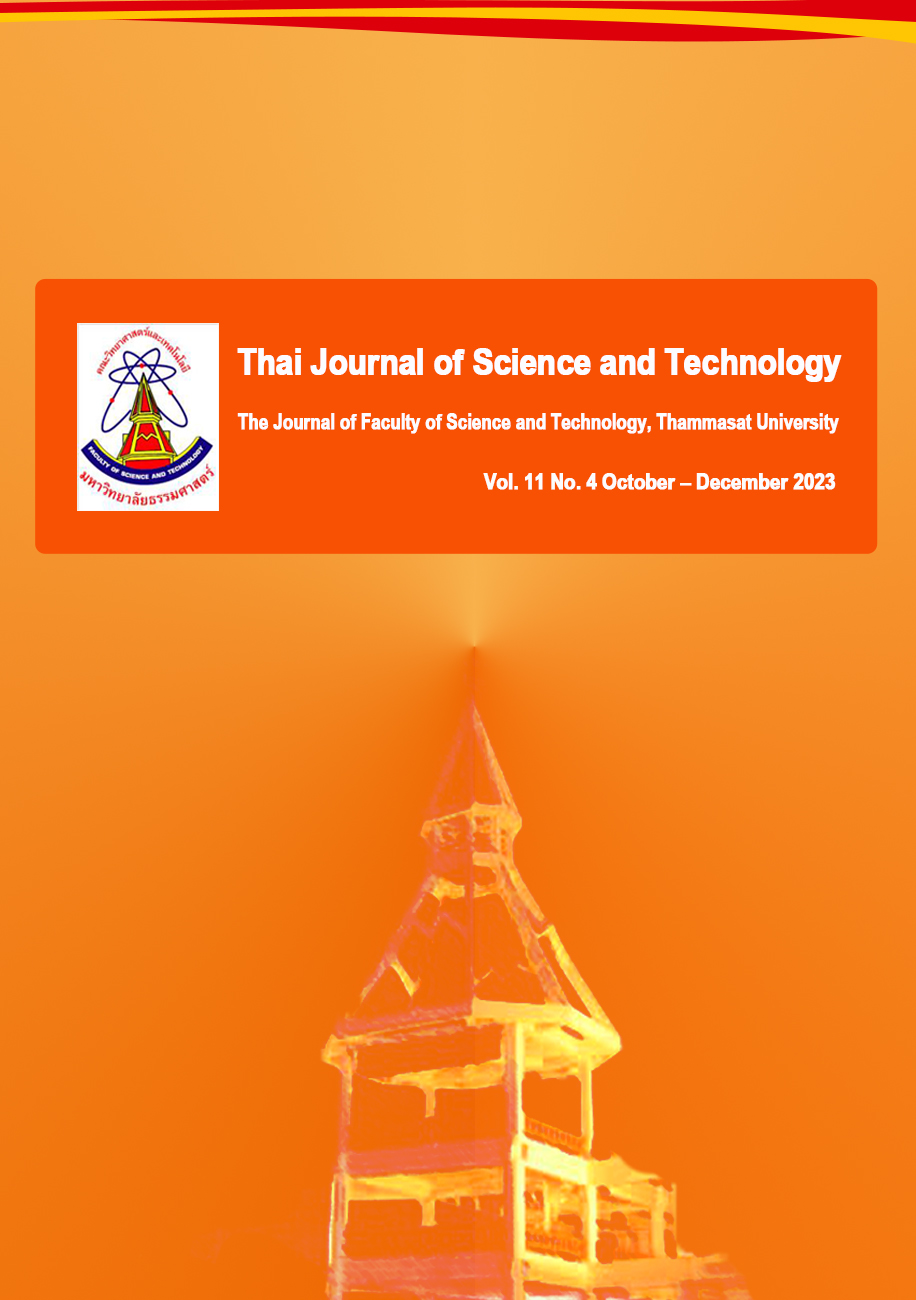Cherry Tomato Backcross Breeding to Increase Sweetness by dCAPS and SNPs Markers in Assisted Selection
Main Article Content
Abstract
Cherry154 is typically consumed fresh, so the taste is essentially required. To enhance their sweetness, the Cherry154 contained a sweetness value at 6-8◦Brix was subjected to backcrossing with Wva700 which contained 9-11◦Brix. Normally, Backcross breeding is used to transfer 1-2 traits of interest from a donor parent to a recurrent parent. This process takes 5-6 generations to fix genetic background from one to another variety. This research used the Kompetitive Allele Specific PCR technique by 200 SNPs marker-assisted backcrossing in each generation to aid in genetic background selection, covering every 5 cM on the tomato genome and analyzing data with the Flapjack program. It also used a dCAPs marker to select the LIN5 gene in order to increase sweetness from backcrossing between Cherry154 and Wva700. The results showed plants in BC1F1 had various recurrent parent percentage (RPP) values from 64-91%, BC2F1 had RPP values varied from 91-81% and BC3F1 were 91-99.6%. Plant in each generation were selected based on their sweetness and high value on RPP percentage. Therefore, the plant contained 8.3 ◦Brix with 88.1% at BC1F1, 9.6◦Brix with 89.8% at BC2F1, and 7.6 ◦Brix with 95.6% RPP at BC3F1 were chosen. It is indicated that a background selection using marker-assisted backcrossing allows plant breeding programs to be potentially precise for trait selection, time-saving, and meeting consumer needs.
Article Details

This work is licensed under a Creative Commons Attribution-NonCommercial-NoDerivatives 4.0 International License.
บทความที่ได้รับการตีพิมพ์เป็นลิขสิทธิ์ของคณะวิทยาศาสตร์และเทคโนโลยี มหาวิทยาลัยธรรมศาสตร์ ข้อความที่ปรากฏในแต่ละเรื่องของวารสารเล่มนี้เป็นเพียงความเห็นส่วนตัวของผู้เขียน ไม่มีความเกี่ยวข้องกับคณะวิทยาศาสตร์และเทคโนโลยี หรือคณาจารย์ท่านอื่นในมหาวิทยาลัยธรรมศาสตร์ ผู้เขียนต้องยืนยันว่าความรับผิดชอบต่อทุกข้อความที่นำเสนอไว้ในบทความของตน หากมีข้อผิดพลาดหรือความไม่ถูกต้องใด ๆ
References
Barone, A. (2004). Molecular marker-assisted selection for potato breeding. American Journal of Potato Research, 81, 111-117.
Foolad, M.R. and Panthee, D.R. (2012). Marker-Assisted Selection in Tomato Breeding. Critical Reviews in Plant Sciences, 31(2), 93-123.
Fridman, E., Carrari, F., Liu, Y.S., Fernie, A.R., and Zamir, D. (2004). Zooming in on a quantitative trait for tomato yield using interspecific introgressions. Science, 305 1786–1789.
Frisch, M., Bohn, M., Melchinger, A.E. (1999). Comparison of selection strategies for marker-assisted backcrossing of a gene. Crop Science, 39, 1295–1301.
Fulton, T., Chunwongse, J., Tanksley, S.D., Masaphy, S., Levanon, D., Henis, Y. and Kelly, S.L.(1995). Microprep protocol for extraction of DNA from tomato and other herbaceous plants. Plant Molecular Biology Reporter, 13(3), 207-209.
Hasan, M.M., Rafii, M.Y., Ismail, M.R., Mahmood, M., Rahim, H.A., Alam, M.A., Ashkani, S., Malek, M.A., Latif, M.A. (2015). Marker-assisted backcrossing: A useful method for rice improvement. Biotechnology&Biotechnological Equipment, 29, 237–254.
Hospital, F. (2003). Marker-assisted breeding. In: H.J. Newbury, editor. Plant molecular breeding. Location: Oxford and Boca Raton: Blackwell Publishing and CRC Press, p.30-59.
Lasuk, R. (2011). Use of molecular markers in tomato breeding to increase soluble solid content and multiple disease resistances. (Master Thesis). Kasetsart University, Bangkok, Thailand. 87p. (in Thai).
Lifomics (2020). KASP genotyping. Retrieved from https://www.lifomics.com/kasp.html, May 10, 2020. (in Thai)
Lübberstedt, T., Beavis, W. and Suza, W. (2023). Marker Assisted Backcrossing. Retrieved from W. P. Suza, & K. R. Lamkey (Eds.), Molecular Plant Breeding, Iowa State University Digital Press.
Milne, I., Shaw, P., Stephen, G., Bayer, M., Cardle, L., Thomas, W., Flavell, A.J. and Marshall, D. (2010). Flapjack-graphical genotype visualization. Bioinformatics, 26(24), 3133-3134.
National Human Genome Research Institute. (2019). The Cost of Sequencing a Human Genome. Retrieved from https://www.genome.gov/about-genomics/fact-sheets/Sequencing-Human-Genome-cost, January 10, 2020.
Noisang J., Luengwilai K. and Chunwongse J. (2019). The development of InDel marker for selection of Lin5 gene associated with sucrose invertase in tomato. King Mongkut's Agricultural Journal, 37(2), 190-199.
Noisang, J. (2018). Study of allele variation in Lin5 gene associated with soluble solid content and breeding for increasing sugar content in cherry tomato. (Master’s degree). Kasetsart University, Bangkok, Thailand. 62p.
Rojkhamlue, T. (2019). Cherry tomato breeding to increase sweetness and cost comparison of backcross breeding methods. (Master Thesis) Kasetsart University, Bangkok, Thailand. 71p. (in Thai)
Smith, S.M. and Maughan P. J. (2015). SNP genotyping using KASPar assays. Location: Humana Press, New York.
Whalen, A., Gorjanc, G. and Hickey J.M. (2019). Parentage assignment with genotyping–by–sequencing data. Journal of Animal Breeding Genetics, 136(2), 102–112.


